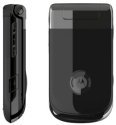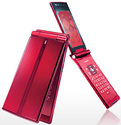Linux smartphone share drops
Sep 10, 2008 — by Eric Brown — from the LinuxDevices Archive — views [Updated: Sept. 11, 2008] — Gartner reported a 15.7 percent rise in smartphone shipments in the second quarter compared to 2Q 2007. Linux, however, was alone among mobile operating systems to lose share from the previous year's 2Q, posting a 16.1 percent drop, says Gartner.
[Updated: Sept. 11, 2008] — Gartner reported a 15.7 percent rise in smartphone shipments in the second quarter compared to 2Q 2007. Linux, however, was alone among mobile operating systems to lose share from the previous year's 2Q, posting a 16.1 percent drop, says Gartner.
(Click for larger view of Motorola's new MotoMing A1600 smartphone)
According to Gartner, only 2,359,245 Linux smartphones shipped during the quarter, down 16.1 percent from the 2,816,490 sold in Q2, 2007.
Gartner's numbers suggest that it is not counting Motorola's high-volume Linux phones in the smartphone category, even though they seem to meet the stated criteria. Gartner's Christy Pettey said the firm defines “smartphones” as:
- Using an “open,” identifiable OS, such as “Symbian, Linux, Windows Mobile, RIM and Apple Mac's OS X”
- Supporting native or managed (i.e., Java) third-party applications
- Supporting multitasking (running more than one application at once)
- Having a user interface that handles multiple applications simultaneously. “For example, it can display e-mail while playing music,” Pettey said.
 Panasonic's new Limo-compliant Panasonic P706iu (Click for details) |
By that definition, Motorola's smartphones would seem to include the Rokr Z6, U9, EM30, and E8 music phones; ZN5 camera phone; and “iconic” general-purpose Razr2 V8. To our knowledge, all of them can play music while showing email, although that is about the extent of their multi-tasking capabilities. And, we'd be surprised if some models — such as the widely distributed Z6 — are not shipping by the millions per month. Gartner did not yet respond to a request for further clarification.
It's also unclear whether Gartner is counting the “MOAP/L” NEC and Panasonic phones, such as the recent Panasonic P706iu (pictured). Our guess is that they are — overall smartphone sales fell a whopping 24 percent in Japan, year-over-year, Gartner said, which would help explain Linux's share loss.
Pettey did confirm that Gartner counts Motorola's MotoMing PDA phones as smartphones. Popular in Asia, these large, touchscreen-equipped devices include the A1200 and the newly shipping A1600 (pictured top-of-page), which launched too late to affect Q2 numbers.
It remains to be seen whether the avalanche of next-generation Linux models expected over the next year based on the Google Android and LiMo Foundation platforms will primarily target the high-end smartphone market, which represents 11 percent of the market according to Gartner, or focus on the higher-volume featurephone market. Historically, Linux has proven more successful as a mid-tier handset OS than its bulkier, more costly smartphone OS competitors, namely Symbian and Windows Mobile. Our guess is that LiMo, driven by Motorola, will tend toward mainstream markets, while early Android phones such as the HTC Dream model expected in October will go after the higher-end marketspace currently defined by the iPhone.
Smartphone market
Smartphone sales totaled 32.2 million units worldwide in 2Q 2008, Gartner reckons, with the segment's share of the total handset market remaining stable at 11 per cent, says Gartner. Despite the rise, and a 22 percent increase in the first half of the year compared to 2H 2007, Gartner reports that smartphone sales increased at a slower rate than in 2007.
“The current economic environment continues to negatively impact the market, limiting consumer spending and replacement purchases in general,” stated Roberta Cozza, principal analyst at Gartner. However, she went on to state, “Wider availability of new touch smartphone models together with the global introduction of the iPhone 3G will help sales of smartphones return to stronger growth in the third quarter of 2008.”
Geographically, smartphone sales declined year-over-year 4.8 percent in Asia/Pacific, and 24 percent in Japan. North American smartphone sales, meanwhile, increased 78.7 per cent, while EMEA (Europe, the Middle East, and Africa) grew 21 per cent.
| Company | 2Q08 Sales | 2Q08 Market Share (%) | 2Q07 Sales | 2Q07 Market Share (%) | 2Q08- 2Q07 Growth (%) |
|---|---|---|---|---|---|
| Symbian | 18,405,057 | 57.1 | 18,273,255 | 65.6 | 0.7 |
| Research In Motion | 5,594,159 | 17.4 | 2,471,200 | 8.9 | 126.4 |
| Microsoft Windows Mobile | 3,873,622 | 12.0 | 3,212,222 | 11.5 | 20.6 |
| Linux | 2,359,245 | 7.3 | 2,816,490 | 10.1 | -16.2 |
| Mac OS X | 892,503 | 2.8 | 270,000 | 1.0 | 230.6 |
| Palm OS | 743,910 | 2.3 | 461,918 | 1.7 | 61.0 |
| Others | 352,679 | 1.1 | 349,501 | 1.3 | 0.9 |
| Total | 32,221,175 | 100.0 | 27,854,586 | 100.0 | 15.7 |
Worldwide preliminary smartphone sales to end users by operating system, 2Q08 (units)
(Source: Gartner)
As seen in the table above, the big winner among smartphone operating systems was MacOS, with a 230.6 percent increase. Research in Motion (RIM), meanwhile, increased 126.6 percent on the strength of its upgraded BlackBerry models. Symbian remained dominant with a 57.1 percent market share, but its growth was flat at under 1 percent, and it lost market share since 2Q 2007, when it represented 65.6 percent of the market. Microsoft's Windows Mobile, meanwhile held its own with a 20.6 percent rise, and Palm showed a surprising 61 percent increase.
Unit shipments by vendor
In handset unit sales by vendor, meanwhile, Nokia's Symbian-based smartphones led the way by far with 47.5 percent of the market, but showed only a modest 8.1 percent increase year over year. RIM and HTC showed the biggest increases among handset vendors, at 126.4 percent and 119.6 percent increases respectively. The other vendors mentioned were Fujitsu, which rose 22 percent and Sharp, which plunged -41.6 percent year over year.
| Company | 2Q08 Sales | 2Q08 Market Share (%) | 2Q07 Sales | 2Q07 Market Share (%) | 2Q08- 2Q07 Growth (%) |
|---|---|---|---|---|---|
| Nokia | 15,297,900 | 47.5 | 14,151,689 | 50.8 | 8.1 |
| Research In Motion | 5,594,159 | 17.4 | 2,471,200 | 8.9 | 126.4 |
| HTC | 1,330,825 | 4.1 | 605,900 | 2.2 | 119.6 |
| Sharp | 1,328,090 | 4.1 | 2,275,401 | 8.2 | -41.6 |
| Fujitsu | 1,071,490 | 3.3 | 877,955 | 3.2 | 22.0 |
| Others | 7,598,711 | 23.6 | 7,472,441 | 26.8 | 1.7 |
| Total | 32,221,175 | 100.0 | 27,854,586 | 100.0 | 15.7 |
Worldwide preliminary smartphone sales to end users by vendor, 2Q08 (units)
(Source: Gartner)
Motorola — which in 2006 rode A1200 sales to become the fastest growing smartphone vendor of the year by Gartner figures — was this year ignominiously lumped in with the “other” category. Yet, after widely publicized difficulties early this year, Motorola appears to be performing better of late, with plans to split off its mobile phone operations as a separate company next year.
Several research groups have recently predicted strong growth for Linux in the smartphone segment. In June, ABI Research predicted that Linux will soar to a 23 percent share of the smartphone segment by 2013. Strategy Analytics pegged the current Linux share of the smartphone market at 15 percent, but said that figure should grow considerably in the coming years. A February study by Canalys reported that Linux share of smartphones and wireless handhelds such as the BlackBerry remained flat at five percent in 4Q 2007, but predicted that Linux would account for a “significant proportion of mobile phone shipments within the next few years.”
Availability
More information on the Gartner study may be found here.
This article was originally published on LinuxDevices.com and has been donated to the open source community by QuinStreet Inc. Please visit LinuxToday.com for up-to-date news and articles about Linux and open source.